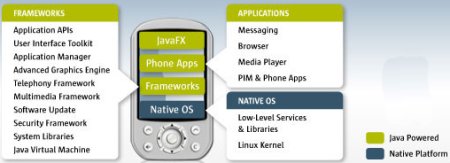Sun beams Linux/Java at mobile phones
May 8, 2007 — by LinuxDevices Staff — from the LinuxDevices Archive — 5 views Sun will ship a “pre-integrated,” GPL-licensable, Linux- and Java-based operating system software reference design for mobile phones, it announced at its JavaOne conference today in San Francisco. “JavaFX Mobile” targets multimedia-enabled phones, and is the first of several planned media-oriented JavaFX-branded stacks, the company said.
Sun will ship a “pre-integrated,” GPL-licensable, Linux- and Java-based operating system software reference design for mobile phones, it announced at its JavaOne conference today in San Francisco. “JavaFX Mobile” targets multimedia-enabled phones, and is the first of several planned media-oriented JavaFX-branded stacks, the company said.
(Click for larger view of FIC hardware running Sun's JavaFX Mobile)
digg this story |
Unlike most Java-enabled phones, which typically rely on the language merely to provide a secure, managed sandbox for user-installed applications, JavaFX Mobile will use Java for almost everything. Whereas the Linux component will consist only of a kernel and “low-level services and libraries,” Java will be used in everything from the UI toolkit to telephony and security middleware to user applications such as browsers and media players.

Sun's JavaFX Mobile architecture
Intriguingly, the stack also targets “content owners,” Sun said. Concurrent with JavaFX Mobile, Sun announced JavaFX Script, a scripting language aimed at creative professionals, and said to “radically simplify the process of creating and distributing interactive content that spans all Java technology enabled platforms, from handsets to set tops, laptops to dashboards.”
Writing about the announcement in his blog, Sun CEO Jonathan Schwartz recited variations on several classic Sun marketing themes to put the news into context. Noting that the “network is the movie theater,” he said that JavaFX products would extend Java's “write once, run anywhere” promise to content creators, in part by lessening the trans-coding burden created by “multi-format proliferation.”
JavaFX Mobile and JavaFX script are expected to be the first of Sun's JavaFX-branded products. The JavaFX product family could grow to include stacks for other classes of devices where Java is commonly deployed, including set-top boxes, navigation devices, and automobile infotainment and driver-assist devices.
All JavaFX products will be available under the GNU GPL, Sun said. When Sun finally GPL'd Java earlier this year, it said the move was calculated to increase Java's adoption in mobile phones.
More details may be available in Schwartz's blog post, and in Sun's JavaFX page.
Perspective
Java is already present on nearly every mobile phone, regardless of OS. However, with JavaFX Mobile, Sun clearly hopes to carve out a bigger space for itself within each mobile phone design. Its success could depend on how quickly Linux mobile phone companies and community developers can rally to match Java's mature application management features.
When Java appeared some 10 years ago, it burst onto the scene with an amount of marketing buzz unheard of for a programming language. However, widely publicized security problems limited adoption early on.
As Sun hustled to seal up all the leaks in Java's “sandbox,” it solved many of the problems that today give pause to large mobile operators in the U.S. and Europe when they consider whether to resell phones based on Linux. Despite “commercial grade” Linux phone stacks from a half dozen vendors (see Related Stories below), no Linux phone stack vendor today can offer the kind of standardized, widely adopted, open-source framework for application installation and management that Java (recently released under the GPL) offers today.
The leading commercial effort to create such a beast is certainly the LiMo Foundation, a powerful industry group aimed at creating a common Linux phone stack. Comprised of many early Linux phone pioneers, including Motorola, NEC, and Panasonic, among others, LiMo publishes “standards” that are only available to organization members, however.
Another contender is Access's GPL-licensed Hiker framework, which aims to provide installation, security, and application management features in a GPL- and LGPL-licensed bundle. Clearly, with its PalmOS legacy, Access understands the value of developer ecosystems.
The open-source OpenMoko effort also includes basic manageability features.
Meanwhile, several industry groups, including LiPS and the Linux Foundation's (formerly OSDL's) Mobile Linux committee are also working to solve the problem of Linux's fragmentation and perceived security problems on mobile phones.
Given Java's head-start in security and manageability, Sun could find quite a few customers for JavaFX, depending on how much it charges for a commercial license. The mobile phone market is a low-margin business at the moment, with even top vendors like Motorola struggling to earn profits.
Alternatively, Linux's ever-rising “value line” demarcating baseline functionality from commercial value-add could ultimately submarine Java's current application manageability and security advantage, especially given Java's reputation for slow application performance.
— Henry Kingman, senior editor
If you have questions or comments about this article, talkback here.
- Access Linux Platform for mobile devices goes gold
- Podcast: mobile phones as “platforms”
- Can Linux save Mot's mobile phone biz?
- Cellphone giants unveil mobile Linux foundation
- Startup plans “complete” Linux smartphone OS
- Trolltech rolls “complete” Linux smartphone stack
- Startup touts Linux mobile phone development services
- Trolltech woos developers with “open” Linux phone
- Mobile Linux OS aims at lower-cost cellphones
- Framework aims to commercialize mobile Linux apps
- Gnome initiative targets mobile and embedded apps
- Sun acquires Java-based mobile phone OS
- Sun GPLs Java, targets mobile phones
- The Linux Mobile Phones Showcase
- Linux phone market opening up?
- Consortium tackles Linux mobile phone standards
- 200 million Linux phones to ship by 2012
This article was originally published on LinuxDevices.com and has been donated to the open source community by QuinStreet Inc. Please visit LinuxToday.com for up-to-date news and articles about Linux and open source.